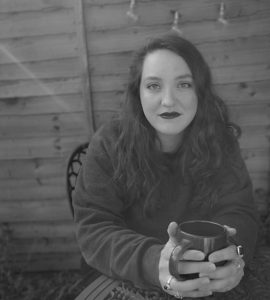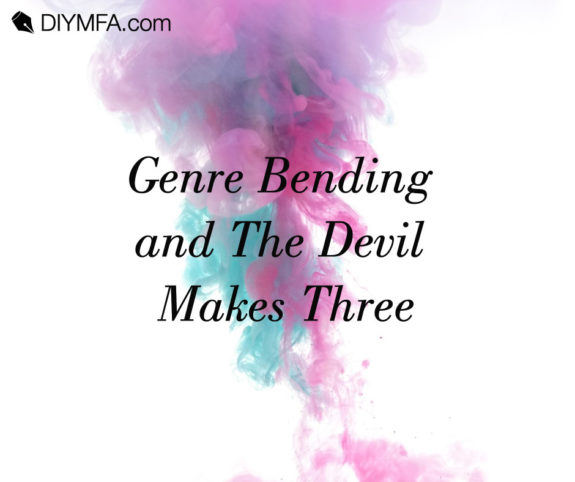When people ask me to talk about my book, The Devil Makes Three, the question of genre always comes up. Now, it’s somewhat obvious simply because it’s practiced: I write horror. This book is horror. That’s not quite how it started, though, and it was a long road to get there. When pitching books, we talk around genres based on trends. Briefly, here are a few other ways I’ve described my debut novel:
- speculative horror
- contemporary fantasy with elements of horror
- contemporary with speculative elements
- dark contemporary fantasy
As you can see, there are a bunch of different boxes we can check to classify our work. If we think of genre like different types of food, what happens to fusion cuisine? How do we write the books we don’t know how to put into tidy boxes?
Deciphering Intent
In my case, it was a matter of deciphering intent. The Devil Makes Three has always been a scary book, but it hasn’t always been a horror novel. It hasn’t always had speculative elements, either.
When bending genre, it’s important to consider the effect of the elements you’re introducing: does a magic system positively impact the book? How does it interact with or grate against other elements you’ve introduced? In The Devil Makes Three, there is both a magic system and an unrelated bookish demon. These elements battled against one another for dominance, so it was a matter of figuring out how the two interacted and interlocked to make them both shine. When the book was accepted for publication, it was like I was whispering quietly in a very large room: can we call this horror? Is it scary enough for that? It can be incredibly difficult to define!
Focusing on Character
Recently, I read Sarah Gailey’s The Echo Wife, which is another delightful experience in genre bending. The premise itself has elements of science fiction in that a primary character is a clone. The setting is contemporary, in a world we recognize. And the concept? That’s horror, and there are excellent moments of terror for both the reader and the narrator throughout. Read deeper to find pieces of a thriller, threads of women’s fiction, and everything in between. It’s a book that is hard to define, so it sits at the crossroads.
Gailey brings these genres together by focusing on character. Evelyn, the main character of The Echo Wife, doesn’t care if her story fits into a genre. The events of the story are driven by decisions. Of course, we could say that every book depends on character and what they may or may not want, but in the course of genre bending, the rules are thrown out the window. Stories can be messy and hard to define—so what is the effect of each decision?
When I was writing The Devil Makes Three, I was focused on my characters rather than genre. I knew I wanted elements of horror simply because I’m drawn to dark narratives and I love scary books. I discovered one of the characters functioned best when he had access to magic, even if it didn’t quite make sense with the original horror-esque plot. But staying true to the characters mattered to me, and it didn’t feel like these characters or this narrative fit into a conventional trope-based plot of a specific genre.
Trends
Genre itself is impacted by trends. Horror is a great specific example of this—it has only been recently that we’ve been calling YA horror books what they are. If a specific genre is seen as unfashionable, it’s sometimes easier to learn how to market a book as something else.
When examining a narrative, it’s a good idea to make a list of descriptors, as I’ve done above. This will allow you to see the different facets of your work.
Utilizing comparison titles is especially helpful in this regard. Consider yourself walking through a bookstore, looking at the different categories. Do you think your book would fit into more than one? Make a list of these different categories and explain to yourself exactly why you think your book or concept would fit into them. This will help you identify tropes and find the best fit for your novel.
In summary, when writing a book, try to focus on character and the big picture rather than specific categories or genres. Sometimes you don’t know what you’ve written until it’s finished. But you also cannot put a genre on a blank piece of paper. Focus on the work itself, and the way the elements interweave. If it’s working, it’s working, so the labels will come later.
And once you’ve written the book, try to position it in the greater publishing landscape. If you’re querying a book or going on submission, you need to know your market anyway. Read anything you can that feels remotely similar to your own work, and pay attention to how those books are marketed. See how the different elements are brought together: are they cohesive, in your opinion? And if not, what could you do differently in your own work?
Genre itself is an amorphous classification based on preconceived notions that will hopefully point readers in the direction of something they like. A genre is a cue: it tells people what to expect.
When you’re mixing genre, the unexpected usually comes up! If you’re going to blend different genres together, the best way to hold it together is with a strong character that drives the story. If we can follow your character from contemporary fiction to portal fantasy to sci fi, we can follow them anywhere.

Tori Bovalino is originally from Pittsburgh, Pennsylvania and lives in London. She holds a BA in English and anthropology from the University of Pittsburgh and an MA in Creative Writing from Royal Holloway, University of London. She is currently a student in Royal Holloway’s Creative writing and practice-based PhD program. Her debut novel, The Devil Makes Three, is forthcoming from Page Street. Tori is represented by Dr. Uwe Stender and Amelia Appel at TriadaUS Literary Agency. You can follow her on Twitter.







